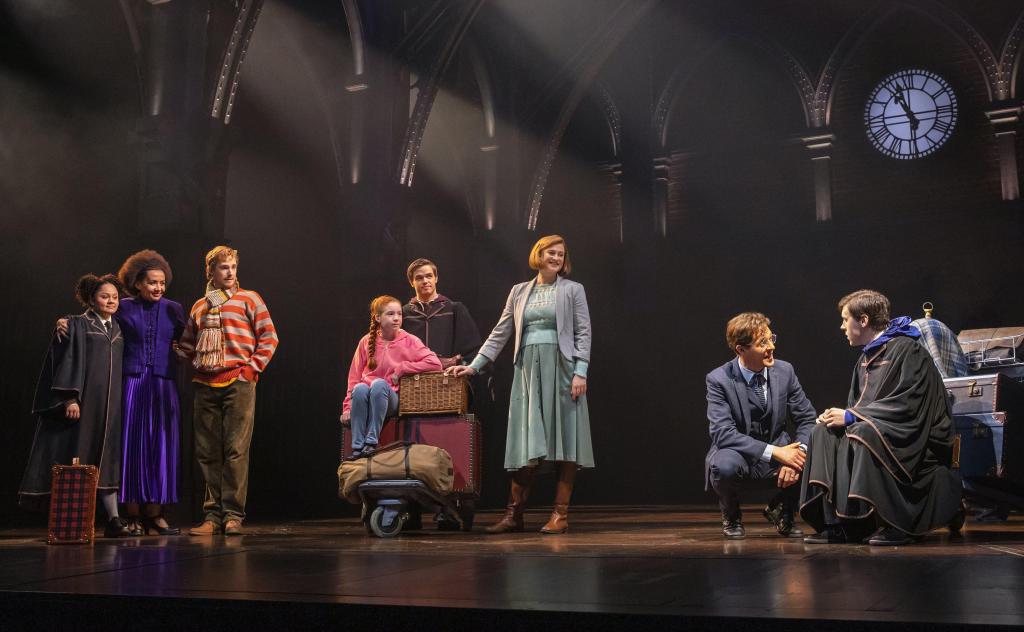After closing for a year, dark clouds around the Fantastic Beasts films and J.K. Rowling embroiling herself in TERF wars, the newly re-opened Melbourne production of Harry Potter and the Cursed Child comes with more baggage than platform 9 ¾. Despite all of this, the production has become independent of its originator and a celebration of what is best about theatre.
Like many Melburnians, we (including our 10-year-old co-reviewer) came to the play after a lockdown spent reading the original books, watching the movies and even constructing the Lego sets, so we were more than ready and expectations were high. Even with masks in place and COVID-safe seating, the theatre production does not disappoint as it walks a fine line between fanservice and rolling out a new story, including a villain to rival Voldemort.
The story passes the baton quickly from the books/films by picking up where The Deathly Hallows left off with Harry (Gareth Reeves) reassuring his son Albus (Sean Rees-Wemyss) before his first journey aboard the Hogwarts Express. Albus soon falls in with Scorpius Malfoy (non-binary trans actor Nyx Calder) and they fall into an adventure to re-write Hogwarts history. From here the story whizzes by thanks to short sharp scenes punctuated with conjuring prop changes disappearing in the twirl of a cape. Calder brings a nerdy charm to the role (‘My geekness is a-quivering,’ Draco announces at a plot revelation) that allows them to do some backstorying around what really happened in The Goblet of Fire. Not much more can be said around plot if we still want to ‘keep the secrets’, as Rowling has encouraged fans and press alike to do since the play’s 2016 West End opening.
Suffice to say the balance between old and new is deftly handled – the first part leans into the original while the second part gleefully tears it up thanks largely thanks to new character Delphi (Gillian Cosgriff). It’s mildly rewarding to see Hermoine Ganger (Paula Arundell) as Minister for Magic, and midlife Harry’s frustrations with paperwork and parenting are attempts to lengthen the character arcs, but the best of the play is where it looks at alternatives to the Battle of Hogwarts and upends the safety of what dedicated Potterheads thought they knew from the originals. According to our 10-year-old reviewer, ‘It was a great storyline and there were several surprising twists.’
Read: The Magic is Back: The Cursed Child returns to the stage
Many wonder if the play’s breaking into two parts of almost three hours each isn’t a bit much, but it rips along, leaving you with cliffhangers at the end of Part One and Part Two’s Third act that make it feel vital rather than nostalgically slow paced. For kids the question of how it could meet the effects of the films are dispensed with by a charming DIY aesthetic – the Hogwarts Express is rendered in suitcases that are swept up in cape waves to become carriage seats, roofs and other inventions. And Polyjuice potions are rendered through surprisingly effective quickchanges. Lighting from Neil Austin sets up the conjuring of characters beautifully, including the centaur Bane, lit to highlight the illusion of human and beast.
Choreographed set pieces roll through the action, from yearning staircase trysts (Hogwarts redesigns itself around separated characters) to martial dance-stomps from Death Eaters. The music of British electropop pioneer Imogen Heap is also pacy and you may come away humming ‘Wand Dance’ unsure how it earwormed itself in, because this is not the bombast of John Williams’ film soundtracks, rather a subtler texture needed for this story. Our 10-year-old reviewer said ‘I loved the effects – they were really simple but still impressive.’ It is the kind of live experience that converts newbies to lifetime devotees of the theatre.
The journey to the stage has seen Rowling wisely hand her characters over to playwright Jack Thorne and director John Tiffany. Thorne and Tiffany worked together previously on Let the Right One In, a coming of rage tale of an adolescent vampire which saw stage success before Rowling waved her wand over their careers. They are no strangers to exploring the difficulties of teens and Thorne has said there is an element of autobiography to the character of Scorpius, whom he said ‘couldn’t fit in with a crowbar’ (in the production book Harry Potter and the Cursed Child The Journey).
Thorne and Tiffany like exploring the darker corners of the story, carefully examining the likes of the Malfoys and ensuring that Draco (Tom Wren, unrecognisable from his TV roles in Winners and Losers and Secret City) is a fully formed character. Rather than the cartoon villain of the films, Wren gives us a man tortured and envious of Harry’s friendships, and the awkwardness of his relationship with Calder’s Scorpius is given more resonance by the casting of a trans actor, as Scorpius and Albus try to understand their relationship and the changes of adolescence. Even the Boy Who Lived suffers from PTSD (allowing for some flashback dreams) and survivor guilt over the cost of his victory over Voldemort. It makes for a more emotionally complex and more adult story than any of Rowling’s work, Including her own literary crossdressing as Robert Galbraith.
At some point writers should let their works have their own lives to prevent them from messing up their legacy. While Harper Lee should have left it at To Kill A Mockingbird (and don’t even get me started on George Lucas) Rowling has handed the torch on with The Cursed Child. With rumours that the play may be slated for a film, we hope it doesn’t meet the same fate as the Fantastic Beasts films or 2020’s The Ickabog (the fairy tale detour from Hogwarts which was critically received with a mixture of ‘Where’s Harry?’ and ‘meh’). Rather The Cursed Child should serve as Rowling’s Patronus – a brilliant ghostly beast that remembers the brightest moments and roams on its own. It may even be bright enough to scatter the dementors of the pandemic.
4 ½ stars: ★★★★☆
5 kid stars: ★★★★★
Harry Potter and the Cursed Child
Stageplay by Jack Thorne
Based on an original story by JK Rowling, Jack Thorne and John Tiffany
Directed by John Tiffany
Movement Director: Steven Hoggett
Set Designer: Christine Jones
Costume Designer: Katrina Lindsay
Composer & Arranger: Imogen Heap
Lighting Designer: Neil Austin
Sound Designer: Gareth Fry
Illusions & Magic: Jamie Harrison
Cast includes: Paula Arundell, Nyx Calder, Gillian Cosgriff, Lucy Goleby, Sean Rees-Wemyss, Gareth Reeves, Michael Whalley and Tom Wren.
Now playing at the Princess Theatre, Melbourne





